Gardening the Archive
Gardening the Archive: A Conversation between David Alesworth and Hammad Nasar
By Hammad Nasar And David Alesworth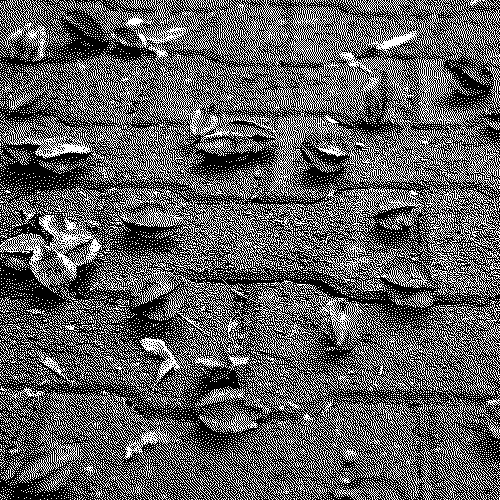
For a contemporary artist, David Alesworth (b. 1957) has an unusual relationship with the landscape. For more than twenty-five years, he has maintained parallel professional lives: as an artist and art teacher; and as a landscape designer and horticultural consultant. Returning to live and work in the UK in 2015, after more than three decades in Karachi and Lahore, his geographic, artistic, horticultural, and biographical entanglements are directly reflected in a heterogonous and wide-ranging body of work featured in the Paul Mellon Centre’s Landscape Now conference (2017). In our cover collaboration with Alesworth for this special issue of British Art Studies, we feature five details from his recent projects that suggest the range of different questions we may pose to landscapes, now.
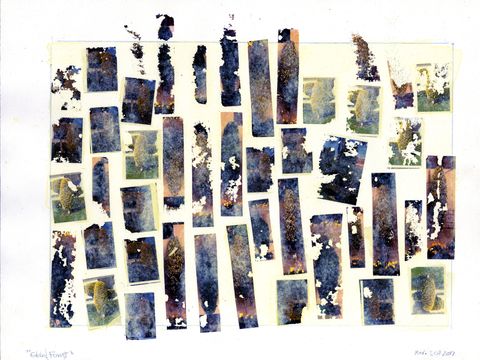
HN:
The distressed collage-like image transfers of clipped trees in Global Forest (2018) reveal a channelled violence, and directly reference Diana Beresford-Kroeger’s book of the same name that examines how trees chemically affect the environment (fig. 1). Are these distinct but similar trees icons of a dystopic landscape?
DA:
Those ritualistically mutilated trees and their distressed reproductions are intended to speak of our dysfunctional relationship with the non-human world. I see urban trees as a frontline in the perpetual battle of culture with nature: where some are coddled and others are brutalized. Kenneth Helphand’s text “Defiant Gardens”, which surveys gardens cultivated in brutal wartime conditions, comes to mind. With this holistic perspective, Kroeger also speaks of the “Global Garden” as containing not only all the world’s forests, but also the entire biosphere, humanity included. This idea is a useful concept for today, maybe offering a prescription for the ills of the Anthropocene, or as Kroeger might phrase it, a workable Bioplan—an idealistic programme for healing this damaged world. Though, as the Trump administration has conceded, it is already too late; we are soon to be cooked along with much else, unless some planetary-scaled geo-engineering enterprise re-sequesters much of that carbon we have so recently liberated.
The works of James Lovelock and Lynn Margulis, and their perspectives informed by deep scientific expertise, are still very much among my influences. One of the first things I did on moving to the UK in 2015 was an extended walk on the Jurassic Coast in the company of Exeter University’s earth systems scientists, some of whom had been taught by Lovelock himself. It was a sobering experience.
HN:
The Hyde Park, Kashan 1862 (2011) is one among a series of textile works where you treat the classical gardens of Persian carpets as palimpsests through which to stage conversations across time and space (fig. 2). You have spoken of these works as heterotopias—where ideas of perfection wrestle with the violence of transforming nature into garden. The forceful driving of large needles through the weft of the carpet is a violent process that easily lends itself to post-colonial readings of the imperial project. What guides your juxtapositions of carpet fragments and the maps they serve as ground for?
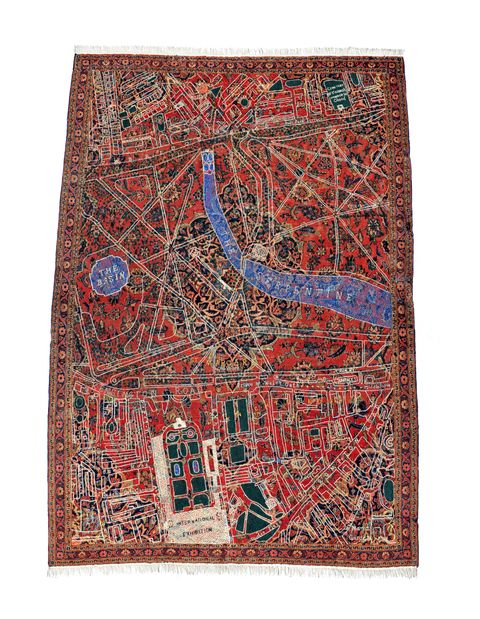
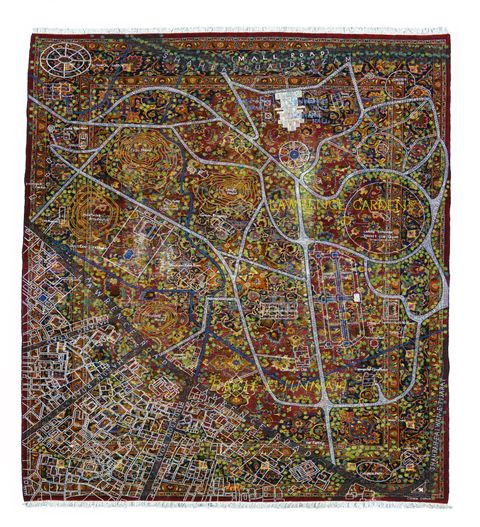
DA:
I consider the carpets I co-opt into these works to be cultural signifiers for the broad Islamic world and its ways of life. It was a late encounter with Foucault’s theory of the Heterotopia that directly led to the genesis of the carpet works. His tantalizingly brief mention of Oriental gardens as containing “seemingly superimposed meanings”, and of Oriental carpets as “reproductions of gardens”, came to me at a point when I was looking for ways to complicate and unpack notions of the garden between cultures and to see it as something other than leisure ground or amenity space.1 In that respect, Lawrence Gardens, or Bagh-e-Jinnah as it is known today, in Lahore continues to be an enormously rich resource for my work (fig. 3). Maps and tribal carpets have so much in common: the containment of a space both practical and symbolic; a certain density of information; and as indicators of world-views.
1I consider all of my working trajectories to be derived directly from my lived experience, and it happens both consciously and sometimes unknowingly. There was a massive Kashan in my childhood. I am still unsure of the stories of its origins within the family. Nor do I know where it went subsequently. It possibly wasn’t any bigger than those I work upon now, and it was soft, worn, and muted—much as those I prefer to work with. Tribal rugs hold to core tenets and yet each is unique, much like a garden—with Eden, foundational to all the Abrahamic faiths, serving as the archetypal garden.
It was Alam the then head mali (gardener) at Lawrence Gardens (or Bagh-e-Jinnah) that set me to research the park’s origins. He told me its layout was based upon Kew Gardens in London. In some ways, this is so; I have never found plans for Lawrence Gardens in the Kew Gardens Archives, but I continue to research its history.
Maps and gardens are both parcels of landscape that may be read and are often whole worlds unto themselves. I tend to work with the antiquated plans of gardens rather than from the direct experience of them, though actually knowing those spaces is important to me. In these works, I hope to complicate the garden and reinstate it as a thinking, spiritual space; anything other than the ubiquitous amenity space gardens have become. In the studio, I think about working as an artist, as I might work as a gardener—it’s a vague enough thought to allow for all kinds of connections both ancient and new, and other emergent possibilities.
HN:
The yellow star-shaped pods which you dispersed along the famous Berlin street in Unter den Linden (2010) are freighted with meaning—of the globalization of plants and people; of symbols of nationhood, but also of alienation—indeed of the infamous yellow star that literally symbolized “otherness” for Germany’s Jews (fig. 4). Is this yet another palimpsest? Do landscapes remember?
DA:
I like to think they do; that all are inscribed by the history and traces of the peoples that have lived in them in some psychogeographical way.
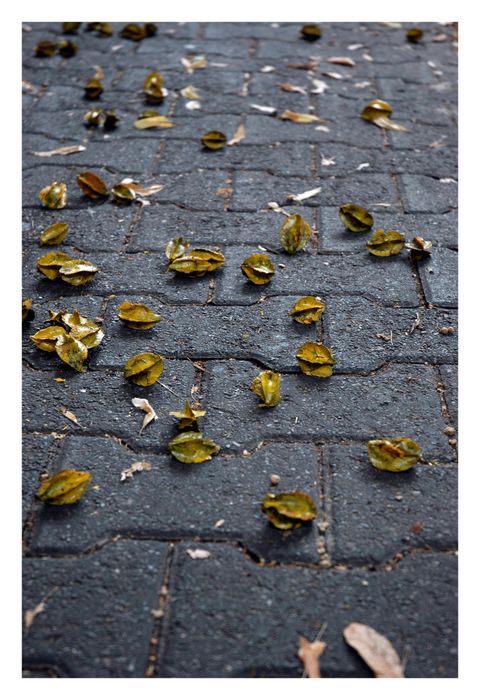
HN:
The Drawing in Time series (2018) of photographs plays with scale; the geographic scale of these land drawings where you used a bulldozer at a cement plant to prepare the limestone dusting for your drawings traced with a stick (fig. 5). And the geological scale that transforms plant matter into coal—which is a layer revealed underneath the surface by your drawing stick (fig. 6, fig. 7, fig. 8). What attracted you to treat the cement factory as a site from which to consider these questions of depth—in time and space?
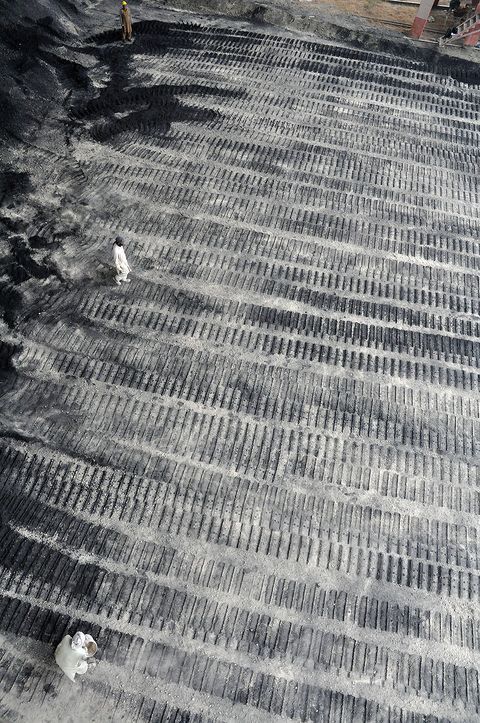



DA:
The site of the Pioneer cement factory in Khushab, Pakistan is around 2,000 acres including the on-site quarries, mineral stores, and two kiln runs. Jetlag, no Internet, no cell coverage, and initially no on-site coordination drove me around the site twice daily for much of the first week. These works were brought about on seeing my footprints in the layers of limestone dust over coal, leaving a jet-black transitory inscription upon those mineral histories.
I had come to the residency at the Pioneer cement factory armed with certain ideas that quickly fell away once I had spent time at the site. In the end, the Drawing in Time works are actually connected to the textile forms I have been working with over the past decade—they both engage with kinds of crafting.
Craft has been an enduring aspect of my practice throughout the time I have spent in Pakistan, because craft in that context is political. It speaks of ways of making, thinking, and resisting that are before, or underneath, the colonial period. The arts of the Bazaar are largely uncontaminated by received notions of art or quality. The carpet works constitute a much higher form of craft practice than my earlier concerns with craft in popular culture and decorated transport in particular, but all share the communality of the horror vacui. The Manchester-based Zeigler and Co. were commissioned to address this irritant and to come up with an aesthetic more suited to European tastes. The legacy of which was the more muted and subdued Zeigler carpet that has now become the Chobi of today. Drawing in Time, with its gentle repetitions, “stitches” these histories, concerns, and thoughts together.
HN:
In the Gardens of England series, you collaborate with the Lahore-based miniature painter Shakila Haider, who transforms your photographs into vaguely otherworldly depictions of Bristol’s front yard shrubbery and trees (fig. 9, fig. 10, fig. 11). Can we read this hybrid imagery as a reverse “Company School” body of work?


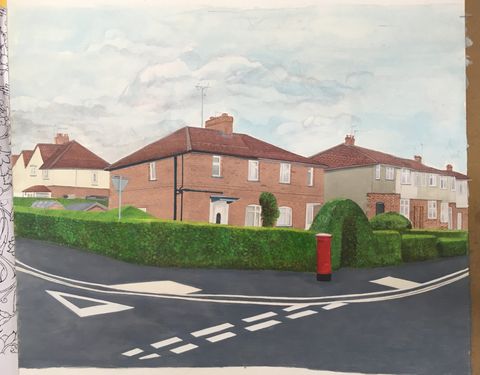
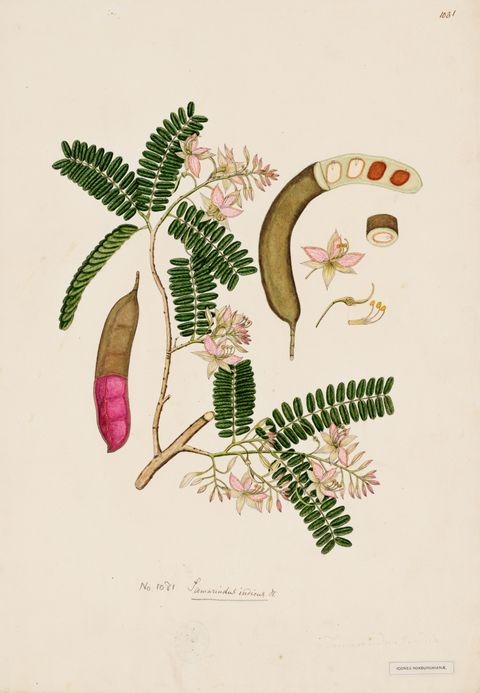
DA:
In the Gardens of England series, I am really thinking of Dr Roxburgh and his “Flora indica”, which controversially documented the flora of India for the East India Company by commissioning two miniature painters (fig. 12). The folios received a mixed response when the Company gifted a set to Kew, the miniature technique producing a somewhat flattened or even “pressed” look to the specimens. But while this reference to Roxburgh was a conscious one, I think that the relationship of Roxburgh and his two miniaturists is very different from my commissioning Haider, with whom I have collaborated closely on other projects. What’s more, contemporary miniature painting in Pakistan is in such high demand now that I needed institutional funding to realize my project.
HN:
Your work rarely depicts people, but its making is often collaborative. In earlier work—for instance, the collaborative project Arz-e-Mauood (Promised Lands) (1997), with Durriya Kazi—the work itself was an activation of a communal space in a public garden, which in a curious coincidence is also called Bagh-e-Jinnah, albeit in Karachi rather than Lahore (fig. 13, fig. 14, fig. 15).2 What are we to read into this apparent withdrawal of people from your more recent work?
2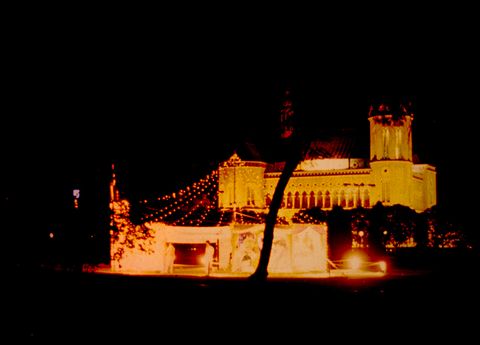
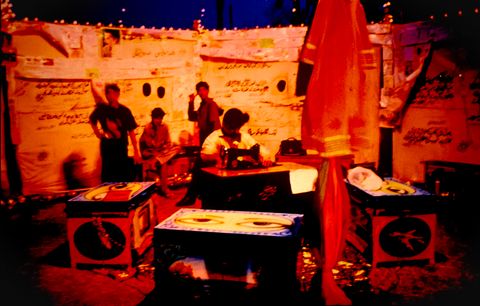
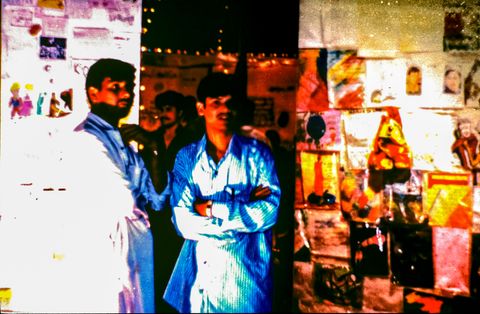
DA:
The imprint of people is always there within my work—written upon the non-human and even the land itself. I grew up in Surrey and was horrified when what I took for natural woodland in the Oxshott woods was one day harvested. We talked plants at home and all had to work in the family garden much to our dismay. Collaborations of all kinds have always seemed natural to me, perhaps the one upside of boarding at a tender age. As a fifteen-year-old, I led a commune of sorts for several years in our school day-room, with shared property—complete with the Little Red Books and Mao posters sent from the Chinese embassy—much to the amusement of our teachers.
More recently, it has been my research in the Kew Gardens Archives that has brought people into my work. The archive that I went into to find an original garden plan actually brought me to some very distinct people who created and then managed the park in its early years: the Garden Directors, Gardeners and their associates and correspondents. It was the age of letter writing, and these letters are always such a pleasure to encounter. The idea of an audio work based upon Lawrence Gardens as revealed through the collections of “The Bulletin of Miscellaneous Information” held at Kew had been on my mind for over a decade. The recent inaugural Lahore Biennale (2018) provided an opportunity for me to assemble some of this research into an audio-work, involving a number of male Colonial voices surrounding that of a single female Punjabi voice, that of Asma Qadri narrating the poems of Najm Hosain Syed (fig. 16).
I say surrounded because that is how I actually modelled the stereo image and the work was hosted in an ancient Camphor tree, one of the oldest in the gardens, one that would have lived through part of the British Raj and is now at the end of its life (fig. 17). I consider the work nascent and hope to revisit and refine it yet; this was one part of my joint proposal for the Lahore Biennale. Assembling The Bulletins of Miscellaneous Information was very collaborative work, involving particularly the English artist Carol Laidler as a co-writer and editor, a local sound studio, both English and Punjabi voice actors, and an equivalent Lahore based setup. The land at Lawrence is itself a palimpsest, if land might be considered so. Its genius loci is derived from a number of elevated mounds surrounded by a depressed ground level, suitable for flood irrigation from meta nallas, and it is still flood irrigated in this way. Those mounds are the remains of the Mughal brick kilns, that built old Lahore from the soil of what became Lawrence Gardens and is now Bagh-e-Jinnah, a sort of botanical garden of Empire gone adrift. The Bulletins of Miscellaneous Information and the Gardens of England both speak of the presence of man, as an infliction upon the landscape. Though ultimately, I confess, I do prefer to work with plants. I now aspire to connect to the land and this moment in the UK—and it is such a troubled moment in so many ways.
I work as a gardener (when not in the studio) as part of my re-entry fee to understanding things English. It is a kind of research for me and is certainly teaching me much about the weather."
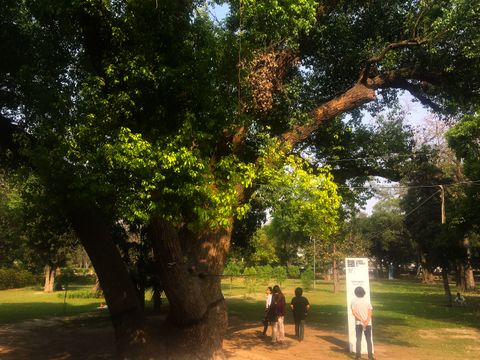
About the authors
-
David Alesworth is a sculptor, photographer, and researcher of garden histories, working between Pakistan and the United Kingdom. He is former Head of Sculpture, Indus Valley School of Art and Architecture (1991–2002), and Professor, BA (Fine Art), Beaconhouse National University, (2006–2015). Over the past decade, his work has been organised around an expanded vision of the garden as a “global forest” of which we are all part. He is a member of the Royal Society Sculptors, and a Stanley Picker Fellowship award holder. In 2016, he was shortlisted for the V&A Jameel Prize. David currently lives in Bristol and is a studio holder at Spike Island.
-
Hammad Nasar is a curator, writer, and researcher based in London. He is co-curator (with Irene Aristizábal) of British Art Show 9 (2020–2022), and a Senior Research Fellow at the Paul Mellon Centre for Studies in British Art, where he co-leads (with Sarah Turner) the London, Asia project. Earlier, he was the inaugural Executive Director of the Stuart Hall Foundation (2018-19); Head of Research & Programmes at Asia Art Archive, Hong Kong (2012–2016); and, co-founded (with Anita Dawood) Green Cardamom, London (2004–2012).
Footnotes
-
1
Michel Foucault, “Of Other Spaces”, (1967), trans. Jay Miskowiec, https://foucault.info/documents/heterotopia/foucault.heteroTopia.en. ↩︎
-
2
See Hammad Nasar, “Karachi Pop: Vernacular Visualities in 1990s Karachi”, https://www.guggenheim.org/blogs/map/karachi-pop-vernacular-visualities-in-1990s-karachi. ↩︎
Imprint
| Author | |
|---|---|
| Date | 29 November 2018 |
| Category | Artist Collaboration |
| Review status | Peer Reviewed (Editorial Group) |
| License | Creative Commons Attribution-NonCommercial 4.0 International (CC BY-NC 4.0) |
| Downloads | PDF format |
| Article DOI | https://doi.org/10.17658/issn.2058-5462/issue-10/cover-collaboration |
| Cite as | Nasar, Hammad, and David Alesworth. “Gardening the Archive: A Conversation between David Alesworth and Hammad Nasar.” In British Art Studies: Landscape Now (Edited by Mark Hallett). London and New Haven: Paul Mellon Centre for Studies in British Art and Yale Center for British Art, 2018. https://doi.org/10.17658/issn.2058-5462/issue-10/cover-collaboration. |

